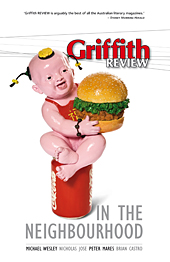Featured in

- Published 20071204
- ISBN: 9780733321276
- Extent: 280 pp
- Paperback (234 x 153mm)

Already a subscriber? Sign in here
If you are an educator or student wishing to access content for study purposes please contact us at griffithreview@griffith.edu.au
Share article
More from author

Illuminations
GR OnlineROAD BUILDERS MADE me slow down. The Surf Highway switched from bitumen to shingle. The hire car, a shiny, gutless tangerine bubble, struggled along...
More from this edition

Capitals of the world
MemoirFor BruceTHIS IS A story about a poor boy in Kathmandu. It is also about his friend and mine, a man so differently placed...

Fear, hope and three days in Dili
ReportageWHEN THE TINY Airnorth plane landed at Dili airport I knew something about campaigning but little about Timorese politics. Like even the most casual...

Gulag
FictionSelected for Best Australian Stories 2007IN THE MORNING we woke and it was like all the mornings we'd imagined. The sun brushed the edges...